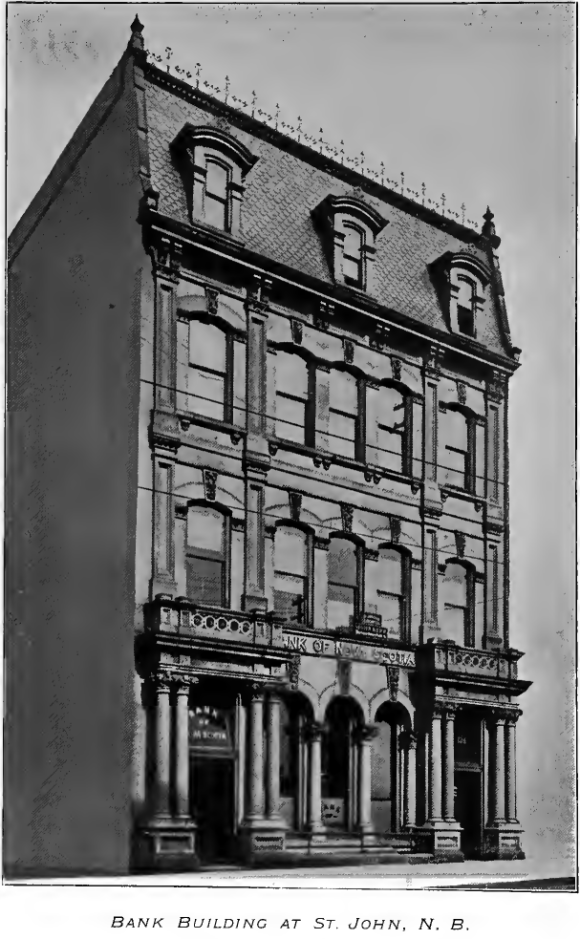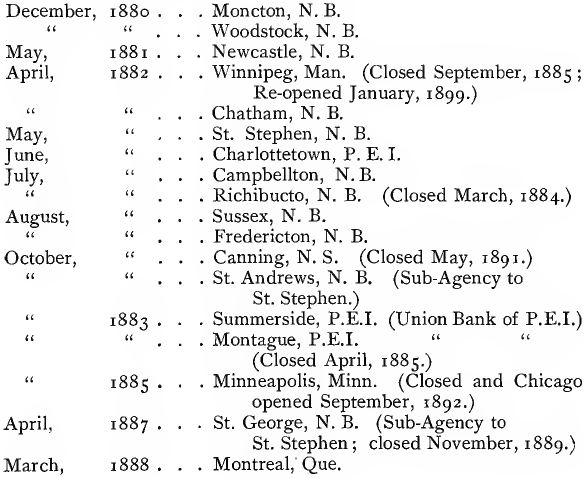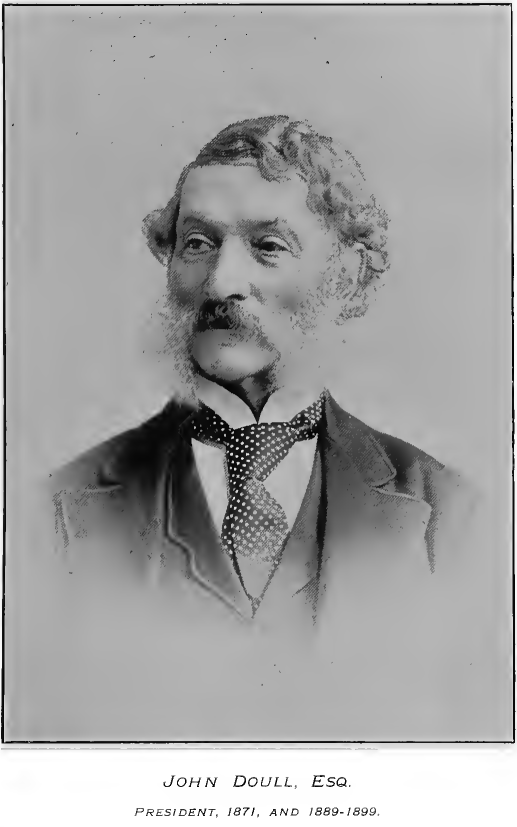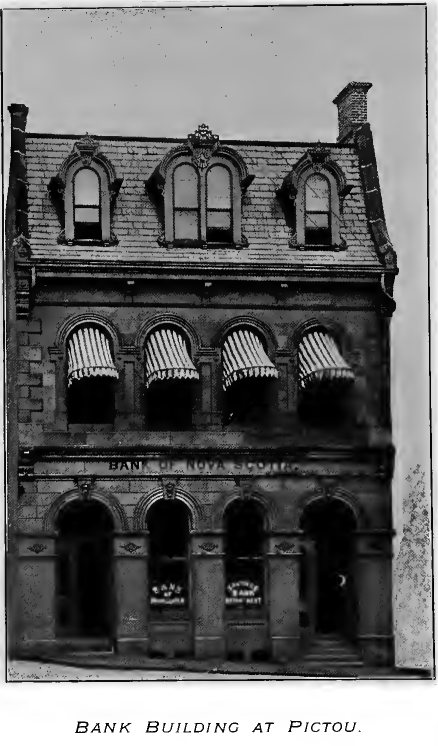|
ON 24th March, 1882,
Mr. J. B. Forgan, now President of the First National Bank, Chicago, was
by special circular appointed Inspector of the Bank, the post being then
definitely created; though examinations — virtually inspections — had
previously been made at various times by the Cashier.
In June of that year the Bank opened at Charlottetown, bought the Bank
of Prince Edward Island Building, and became, through its Agent, Mr. D.
C. Chalmers, one of the three liquidators of that Bank.
The proceedings of the fiftieth annual meeting show that amalgamation
schemes were in favor. The Directors passed a resolution on 12th
September approving of the absorption of the Union Bank of Prince Edward
Island, and a special meeting of Shareholders was called for 20th
November, 1882. The basis on which the agreement was to be effected was
as follows:
First.—That the intrinsic value of each stock should be arrived at.
Second.—That the intrinsic value of one stock should be increased or
diminished relatively to the other by differences in earning power,
present or prospective. The present and prospective earning power of
each stock should therefore be taken into consideration and the
intrinsic value altered accordingly. In calculating the present and
prospective earning power of each stock, regard should be had to its
past earnings only after deduction of losses.
Third.—When the real value of each stock has thus been ascertained they
can be equalized by raising or reducing the capital of the one till the
value of each hundred dollars of stock in the two banks shall be equal,
dollar for dollar. New capital stock of the Bank of Nova Scotia can then
be issued for the capital of the Union Bank thus fixed.


At the annual meeting
on 21st February, 1883, a resolution was passed to the effect “that the
Dominion Legislature be applied to for authority to reduce the nominal
value of this Bank’s shares from two hundred dollars to one hundred
dollars, and to double the number of shares, so that the present share
will represent two shares.” This was to facilitate the exchanging of the
Bank’s stock for that of the Union Bank of Prince Edward Island—the fact
that this permission had been given by Parliament on 26th May, 1874, had
apparently been forgotten; and the Act providing for the amalgamation
contained a clause thereby reducing the shares of the Bank of Nova
Scotia from two hundred dollars to one hundred dollars each. This Act,
assented to 25th May, 1883, provided that the agreement should be
confirmed by a majority of two thirds of the Stockholders of each bank
at special meetings to be called for that purpose; that a deed of union
be signed and filed with the Secretary of State of Canada; that upon the
union taking place the holders of Union Bank stock should become ipso
facto shareholders in the Bank of Nova Scotia—the latter having to pay
fractional parts of shares in cash, if necessary; and that the Bank of
Nova Scotia might issue notes in excess of the amount of its paid-up
capital to the extent of twice the paid-up capital of the Union Bank as
at 31st March, 1883, the Act to continue in force till 1st July, 1891.
This exceptional privilege in the matter of Circulation was granted in
lieu of similar rights enjoyed by the Union Bank of Prince Edward Island
under its Provincial Charter, to expire 1st July, 1891. A meeting of
Shareholders was held on 8th August, 1883, for the purpose of confirming
the amalgamation agreement, but was adjourned until the nth of the next
month as the Directors of the Union Bank had not finished their
examination into the affairs of the Bank of Nova Scotia. On the latter
date the amalgamation was completed, the Bank of Nova Scotia issuing
$114,241 of stock to the Union Bank Shareholders—or the equivalent of
$162,222.22 in cash. The formal indenture of union was signed on 26th
September, 1883, and went into effect on the first of the next month,
the Bank thus acquiring established Agencies at Summerside and Montague,
in addition to increasing its business at Charlottetown. The Agency at
Montague was continued until April, 1885, and then closed.
Agencies opened since 1880 are as follows:


On October ist, 1883,
on the occasion of the President’s departure for a European tour, Mr.
Adam Burns was elected a Director, the number being thus increased to
six. The next August Mr. Jairus Hart was chosen to fill Mr. J. J.
Bremner’s place, the latter ceasing to be a shareholder. At the annual
meeting in 1886 Mr. S. A. White’s name was dropped from the list, he
having taken up residence abroad; and the number again limited to five.
At the close of 1884 it was found necessary to write off $130,000 from
the Reserve Fund to meet large losses developed during the year.
In April, 1886, the Bank took over the affairs of the Pictou Bank and
proceeded to liquidate them.
The Officers’ Mutual Guarantee and Savings Fund of the Bank of Nova
Scotia was established in September, 1886; and the Officers’ Pension
Fund in January, 1888.
On 29th April, 1889, Mr. John S. Maclean, President of the Bank from
1874, passed away. Mr. John Y. Payzant was elected to fill the vacancy
'in the Board; Mr. John Doull became President, and Mr. Adam Burns,
Vice-President. Mr. Daniel Cronan, a member of the Board for
twenty-seven years, died on 22nd September, 1892, his place being filled
by Mr. R. B. Seeton.
At the time of the financial collapse in Newfoundland (December, 1894),
the Banks there having failed, this Bank sent assistance at the earliest
possible opportunity, as did also the Bank of Montreal and Merchants
Bank of Halifax.
Mr. Adam Burns died in February, 1897. Mr. Payzant was on 15th June
chosen Vice-President, and Mr. Charles Archibald elected to fill the
vacancy in the Board.
On June 18th, Mr. Fyshe resigned, to accept the position of Joint
General Manager of the Merchants Bank of Canada, and Mr. Henry C.
McLeod, who had for ten years represented the Bank in Minneapolis and
Chicago, was appointed Cashier.


The titles of “General
Manager” and “Manager” were substituted for those of “Cashier” and
“Agent” respectively, throughout the Bank in 1898.
On 20th June, 1899, the number of Directors was increased to seven, the
new members being Mr. R. L. Borden and Mr. G. S. Campbell. In the
following September Mr. Doull died, Mr. Jairus Hart succeeding him, and
Mr. J. Walter Allison being added to the Directory. Mr. Hart resigned in
December, on account of advancing age; Mr. Payzant becoming President,
and Mr. Archibald, Vice-President: the Board
remaining at six in number. The last change in the. Board to be recorded
is the death of Mr. Seeton, in March, 1900, and the election of Mr.
Hector Mclnnes on 24th April.
In July, 1899, the Bank of Nova Scotia, which had joined the Canadian
Bankers’ Association at its inception, withdrew therefrom, for reasons
which have been made public.
The General Manager’s Office was removed to Toronto in March, 1900. |
